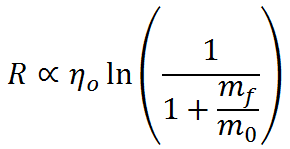Connections
To conclude this section on propulsion principles, we connect the concepts and results of this section with the objectives of propulsion as presented in the Objectives section
Speed and Acceleration: For an animal to capture prey or avoid a predator, or for one vehicle to intercept another, it is desirable to accelerate quickly and maintain a high top speed. The controlling factor for these characteristics is thrust. A large thrust will provide a large acceleration from rest and a large cruise velocity. Based on  , a large Ve or
, a large Ve or  is required for large thrust. At the same time, increasing
is required for large thrust. At the same time, increasing  or Ve may require a larger propulsion device. For example, increasing
or Ve may require a larger propulsion device. For example, increasing  might require a larger propeller and increasing Ve may require more equipment. A larger propulsion device increases mass and drag, which lowers acceleration and top speed for a given thrust. Thus, a compromise is typically necessary. Notice also that FT also depends on V0, so variation of thrust with vehicle velocity is an important consideration in designing a propulsion system.
might require a larger propeller and increasing Ve may require more equipment. A larger propulsion device increases mass and drag, which lowers acceleration and top speed for a given thrust. Thus, a compromise is typically necessary. Notice also that FT also depends on V0, so variation of thrust with vehicle velocity is an important consideration in designing a propulsion system.
Range and Endurance: The ability to maximize distance traveled (range) or the total time the propulsion system is active (endurance) also depends strongly on the performance of the propulsion system. To begin with, the rate of energy expended by a propulsion system may be expressed as

where  is the rate at which fuel mass or energy stores are used up and Qf is the energy density (energy per unit mass) of the fuel or stored energy. Using this result in the definition of overall efficiency we have,
is the rate at which fuel mass or energy stores are used up and Qf is the energy density (energy per unit mass) of the fuel or stored energy. Using this result in the definition of overall efficiency we have,

Thus, higher efficiency leads to a lower rate of fuel consumption. In particular, if we use this result to solve for the range, R, of a vehicle at a constant velocity we can show that

for flying vehicles (aircraft and birds), and

for submarines and fish. In these results, mf is the total mass of fuel/energy stores on board and m0 is the empty weight of the vehicle (mass with no fuel on board). (For flying vehicles, a natural logarithm appears because the required thrust is a function of the vehicle mass, which decreases as fuel is expended.) One conclusion from these results is that fuel economy (R / mf) is directly affected by the design of the propulsion system through η0. Likewise, endurance, Te, can be determined directly from range as

Hence, η0 directly affects endurance as well.
For examples of cases where large range and/or endurance are crucial, see the Objectives section.
 , a large Ve or
, a large Ve or  is required for large thrust. At the same time, increasing
is required for large thrust. At the same time, increasing  or Ve may require a larger propulsion device. For example, increasing
or Ve may require a larger propulsion device. For example, increasing  might require a larger propeller and increasing Ve may require more equipment. A larger propulsion device increases mass and drag, which lowers acceleration and top speed for a given thrust. Thus, a compromise is typically necessary. Notice also that FT also depends on V0, so variation of thrust with vehicle velocity is an important consideration in designing a propulsion system.
might require a larger propeller and increasing Ve may require more equipment. A larger propulsion device increases mass and drag, which lowers acceleration and top speed for a given thrust. Thus, a compromise is typically necessary. Notice also that FT also depends on V0, so variation of thrust with vehicle velocity is an important consideration in designing a propulsion system.
 is the rate at which fuel mass or energy stores are used up and Qf is the energy density (energy per unit mass) of the fuel or stored energy. Using this result in the definition of overall efficiency we have,
is the rate at which fuel mass or energy stores are used up and Qf is the energy density (energy per unit mass) of the fuel or stored energy. Using this result in the definition of overall efficiency we have,



